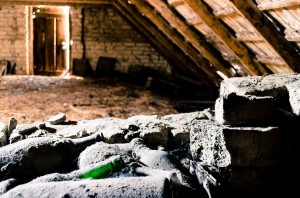Understanding the Risks of Asbestos and Lead at Home
Asbestos and lead are some of the most hazardous substances to human health. A presence of these materials in the home can lead to health problems over time with regular exposure. Identifying these environmental risks is the first step to remediating a potentially serious problem. Both asbestos and lead based paint are found in older homes. While you may never know if your home is contaminated with these substances, as they deteriorate or are disturbed the risks of cancer and lead poisoning may increase with exposure.
If you are buying a home or suspect that your existing home may have either of these substances, you should have them tested and then assess the costs and impacts of having them removed. In some cases, if asbestos based insulation has not been disturbed and is present in a small enough quantity, it may not be an immediate concern. For lead based paint, removal or a thorough repainting is typically a good solution.
Asbestos and Lead Paint Solutions
Asbestos-
Once you have identified where the potential problems are, determining what will be the most effective solution is the next step. Identifying the levels of asbestos contamination is important to verify whether or not the asbestos is a problem that needs immediate attention. The asbestos removal process can actually present more health risks than leaving the asbestos based materials undisturbed. The release of the particles into the air is the primary risk factor in the removal process. In some instances, containment is the better solution. Since asbestos is a known carcinogen, it is best to avoid damaging or disturbing substances that contain asbestos. Sealing and covering the affected areas is sometimes preferred to prevent the particles from becoming airborne and entering vents and becoming trapped in furniture.
If you decide to have asbestos removed, you will need to factor in the costs of sampling the contamination levels and ultimate removal or management. Depending on the nature of the circumstances, these services may be necessary or optional. For example, if you are planning on doing renovations or remodeling work where asbestos containing materials may be damaged or disturbed, having the asbestos professionally removed may be mandatory. Likewise, if the material is found to be subject to deterioration over time, emergency services might also be necessary to quickly remediate problems.
Lead Paint-
Lead based paint is commonly found in homes constructed prior to 1978 where the paint has not been updated and may be peeling or flaking. Lead paint becomes a problem when the dust is airborne and inhaled or otherwise ingested. Young children are particularly susceptible to lead paint poisoning. The EPA mandates that lead hazard abatement pamphlets accompany homes built before 1978 during a sale to inform the buyer of potential risks and give them 10 days to conduct an inspection. Much like asbestos, addressing lead paint through containment is often the more practical solution since the removal process can cause more problems. Walls and ceilings that are in good condition and have been painted over several times with a non-lead based paint pose little risk.
In fact, many homeowners do not know if lead based paint was used in their homes and most have not tested for it. If you own or are looking at buying a home built before 1978 and notice walls or ceilings in poor condition with chipped or peeling paint, have the area tested and determine the best solution to address any lead based paint–either through repainting or complete removal.


